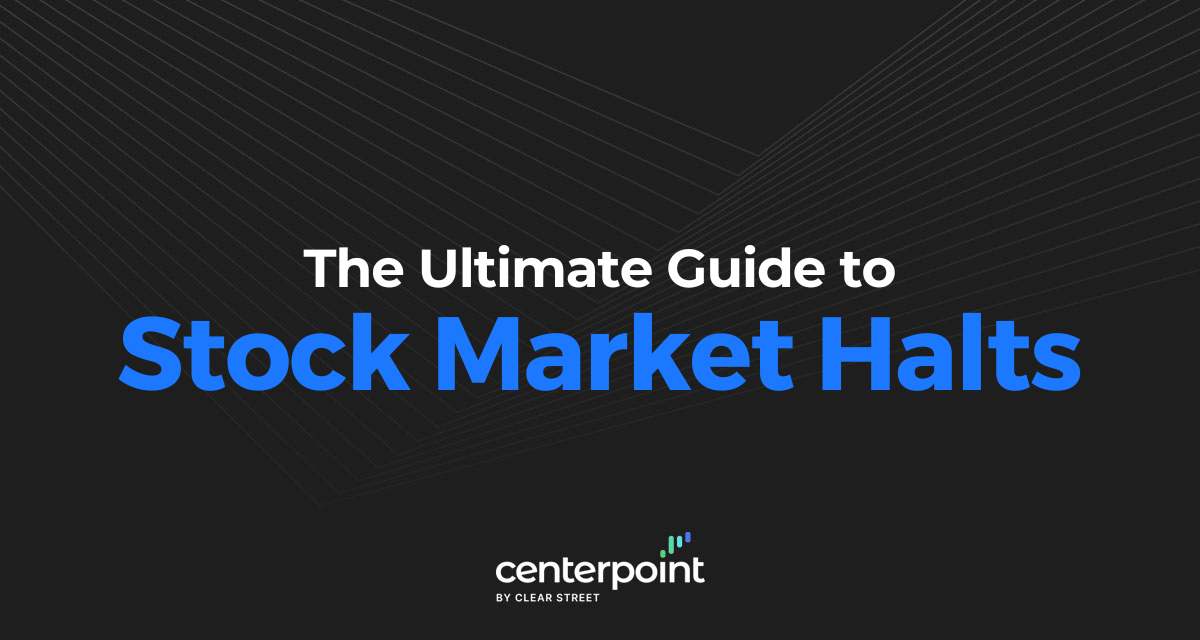Stock market trading halts have made mainstream headlines in 2020, as markets experienced extreme volatility with unprecedented magnitude and velocity triggered by the coronavirus pandemic. Traders who weren’t around during the 2008 financial crisis are likely experiencing exchange halts for the first time. While seeing quotes freeze across the board can feel unnerving, rest assured as these parameters were created as a result of market disruptions in the past.
What Is A Halt?
A trading halt freezes all trading activity for a certain period of time. It’s important to distinguish between a market-wide trading halt which stops trading in all stocks and an individual stock trading halt.
For stock market wide halts, also referred to as trading curbs and market-wide circuit breakers, this action is meant to buffer volatility, calm done markets and enable participants to “pause” and take a breather. A market-wide trading halt occurs when the S&P 500 index falls a set percentage below the previous closing price.
Individual stock halts are initiated by the specific stock exchange where the stock is listed. Individual stocks can be halted for news, volatility, or regulatory reasons.
Types of Trading Halts
Stock exchanges initiate all trading halts, but not all trading halts are the same. There are four general types of trading halts:
Market Wide Circuit Breaker Halts
These are trading curbs that completely stop all trading in U.S. stock markets when the benchmark indexes exceed pre-set percentages from the previous closing price.
There are three levels of circuit breakers.
- A level 1 circuit breaker halt freezes trading on all U.S. exchanges for 15-minutes when the S&P 500 index falls 7% below the previous day’s closing price between 9:30 am EST and 3:24 pm EST.
- A level 2 circuit breaker halts trading for 15-minutes when indexes fall 13% below the prior day’s closing price between the market hours of 9:30 am EST to 3:24 pm EST. If benchmark indexes reach the level 1 or level 2 circuit breaker price thresholds of 7% and 13% after 3:24 pm EST, markets will continue to trade without a halt until the 4 pm EST close.
- A level 3 circuit breaker shuts down all trading for the remainder of the day until 4 pm EST, if the S&P 500 index falls 20% below the previous day’s closing price.
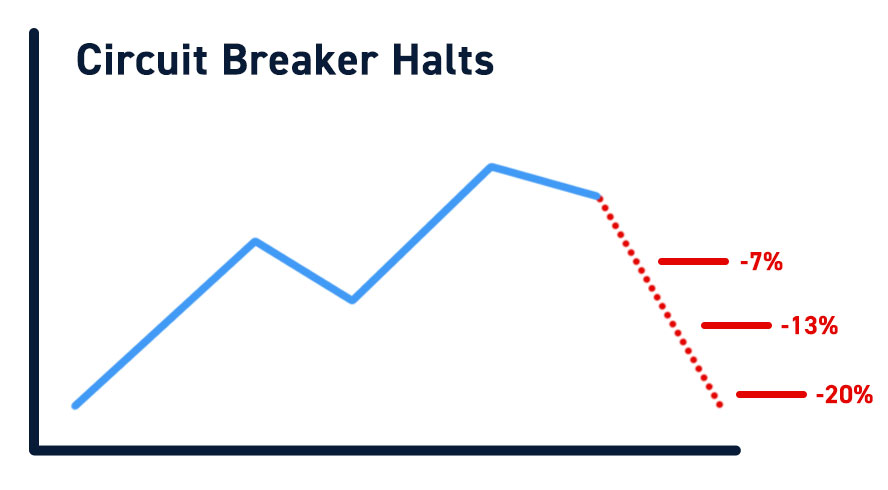
Futures Halts
In after hours trading, the S&P 500, NASDAQ 100, and DJIA futures contracts trigger trading halts when they fall 5% below (lock limit down) or 5% above (lock limit up) their respective closing prices. However, this still enables stocks and ETFs to continue trading in the after hours sessions. The S&P 500, NASDAQ 100, and DJIA exchange-traded-funds (ETFs) trading prices can give a better indication of where the markets are trading even when the futures are frozen.
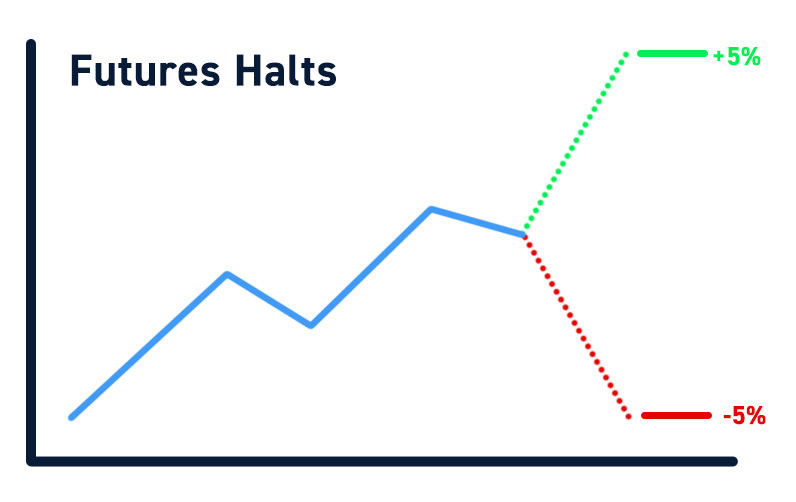
News Halts
News halts pertain to “News Pending” related catalysts or events that can have a sharp and material impact on stock prices. These types of halts are usually requested directly from the underlying company in anticipation of potential price volatility in reaction to a pending announcement.
Some of the more common events can be earnings-related (i.e., earnings guidance raise or cuts), corporate actions (i.e., CEO resignation/replacement, acquisitions/mergers), FDA drug approvals/rejections, legal rulings/judgments (i.e., patent settlement) and tender offers/solicitations. Specifics can often be found on an 8-K filing that often proceeds the announcement.
News related trading halts can last from 15-minutes to overnight depending on when the trading halt enacted and the type of news. For example, a trading halt for a biotech stock ahead of an FDA advisory panel vote could last a full day, whereas an earnings warning could last until 15-minutes after the announcement.
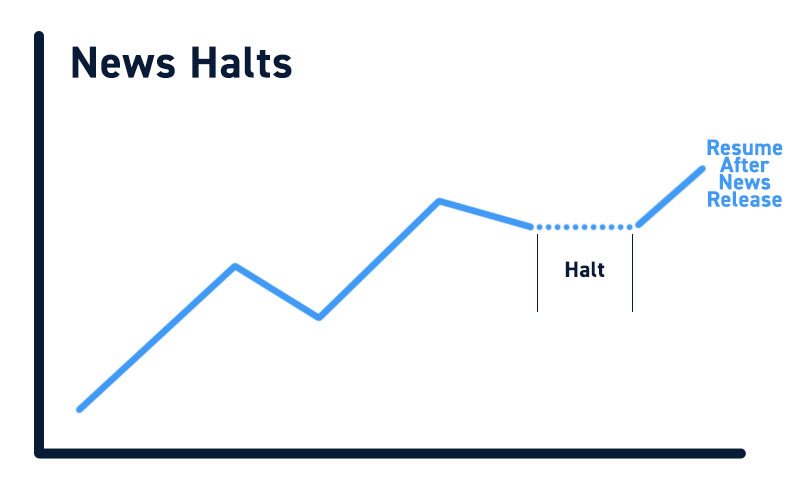
Volatility Halts
Volatility halts are single stock circuit breaker halts that trigger 5-minute halts on fast price spikes or drops that exceed the acceptable trading price range (ATPR) for 15-seconds. The ATPR is calculated as the average price of the previous 5-minute trading period.
Different stocks have different ATPR ranges. Volatility halts trigger when shares exceed 5% of the ATPR for Tier 1 National Market Systems (NMS) listed securities on the S&P 500 and Russell 2000 priced above $3.00-per share between 9:45 am EST to 3:30 pm EST market hours and 10% of the first 15-minutes and last 25-minutes of market hours.
Tier 2 stocks halt above 10% of ATPR between 9:45 am EST to 3:35 pm EST and 20% of ATPR in the first 15-minute and last 25-minutes of market hours. Other stocks’ prices between $0.75 and $3.00-per shares triggered volatility halts above 20% of APTR between 9:45 am EST to 3:35 pm EST and 40% in the first 15-minutes and final 25-minutes of market hours.
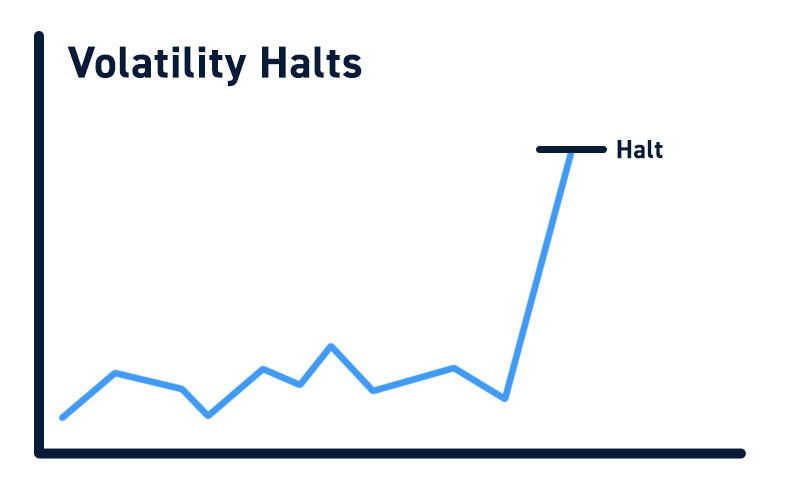
Compliance Halts
Compliance halts can be originated by regulatory bodies, including the Securities and Exchange Commission (SEC), Financial Industry Regulatory Authority (FINRA), or the stock exchanges (NYSE, AMEX, and NASDAQ). Stocks can be halted for any number of non-compliant filing issues (i.e., failure to file or non-current 10-Q), de-listing, or requests for more information (i.e., unusual trading activity) from the stock exchanges. An SEC suspension trading halt can be devastating to shareholders as the implication/accusation of fraudulent activity could result in total loss of value.
How To Trade Halts
Trading halts may provide opportunities for experienced and nimble traders when trading activity resumes. However, the practice is highly speculative and can result in significant to complete loss of capital if you are on the wrong side of the trade. Often, the trading halt can create, rather than relieve, massive order imbalances that induce a panic reaction. This volatility enables potential reversion trades and trend trades for the most aggressive and highly experienced traders.
However, it’s no fun being stuck in a stock that abruptly gets halted. While certain types of halts are impossible to predict (i.e., compliance halt), volatility halts can be avoided to some degree. If you are trading a stock that spikes beyond the ATRP for 15-seconds, then chances are a volatility halt is coming. While it can be difficult to remember the applicable ATRP thresholds, just remember if your stock doubles in a few minutes, then expect a halt and react accordingly.
It’s also wise to avoid trading extremely volatile stocks that are moving double-digit percentage ranges intraday. News pending halts can be avoided if there’s a scheduled event like an FDA advisory panel vote or an earnings release.
What To Do If Your Stock Is Halted
If you happen to be in a stock that gets halted, the most important thing is not to panic. Volatility halts resume after 5-minutes. However, news or compliance halts can be more daunting situations.
The NASDAQ site offers a useful reference for confirming the type of trading halt your stock falls under as well as having an up-to-date list of stock halts. It also lists the time of resumption, which will enable you to research and analyze charts to prepare for the reaction.
Speed is of the essence when a halted stock resumes trading. Having a direct market access (DMA) broker with multiple order routing capabilities will give you an advantage over regular discount broker executions. Be aware of added volatility from potential margin calls and forced liquidations. Having the control to perform instant executions directly through ECN limit books, and bypassing market makers, during chaotic volatility can mean the difference between losing a toenail or a foot during the chaotic panic-driven action that follows upon trading resumption.

